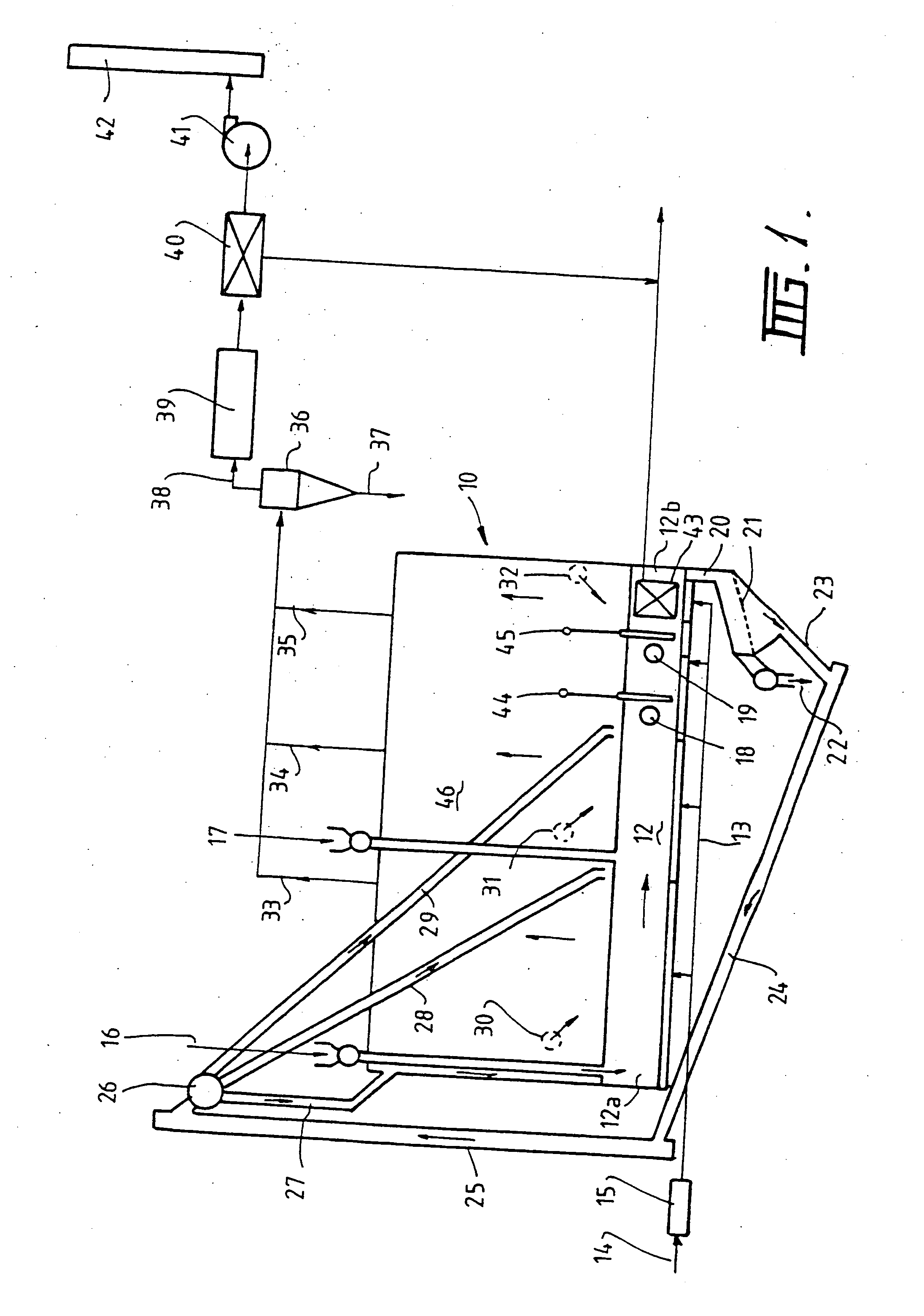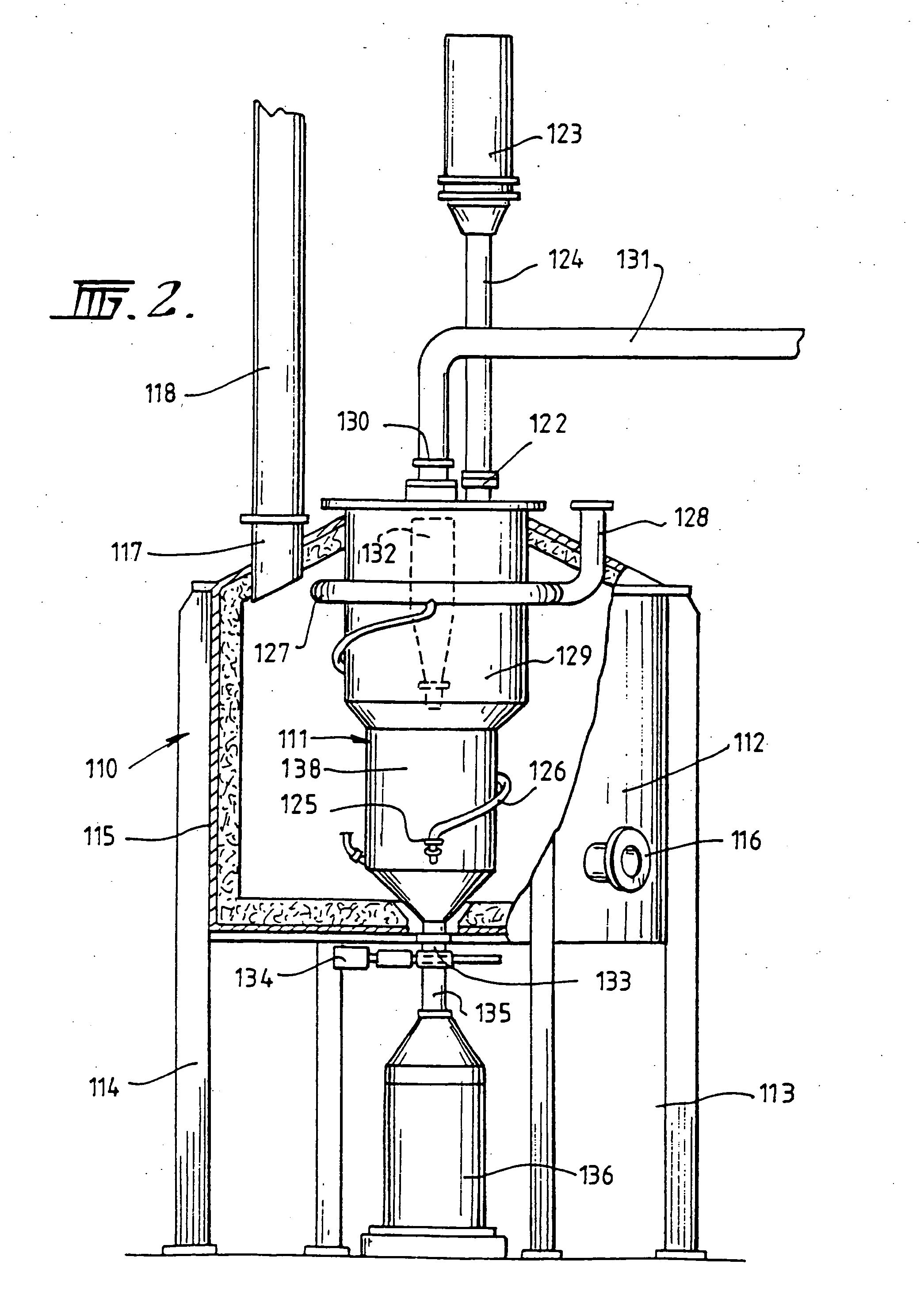[0033] The
inert particulate material may comprise any suitable
particulate material that is able to be fluidized and does not undergo substantial reaction in the operating conditions experienced in the fluidized
bed. Sand is a suitable
particulate material for use in the present invention. Fine sand is preferred over coarse sand because fine sand gives better
heat transfer to submerged surfaces (such as a
heat exchanger within the bed) and to cold feed particles of wood residues and promotes better
combustion of volatile gases within the bed. Fine sand also causes less attrition of submerged surfaces and products then coarse sand.
Ilmenite sand has been found to be particularly suitable because it has a fine size (typically below 1 mm), is very dense,
wear resistant and has a high
melting point. Thus, it can be used over a wide range of operating conditions.
Ilmenite sand is a naturally occurring, relatively abundant, low cost material.
[0037] By maintaining an excess of
oxygen in the bed,
charcoal production is controlled by the
kinetics of the
combustion of the
charcoal and
volatiles. At lower bed temperatures, typically 400° C.-500° C., the rate of
combustion of
charcoal is slow and
recovery of charcoal can be high. At high temperatures above 600° C., charcoal can burn rapidly and result in complete combustion. If bed temperatures are too low, such as 400° C. or lower, the rate of combustion of
volatiles can become too slow to maintain the heating of the bed and much of the
volatiles can escape the bed without burning. When this occurs, supplementary preheating of the bed may be necessary and if the preheat burners can not burn the volatiles escaping from the bed, an
afterburner may also be required to eliminate the
discharge of unburnt volatiles.
[0038] Heat can be recovered from the combusted off-gases by using a
heat exchanger. It is also possible to recover heat from the bed with a
heat exchanger submerged in the fluid bed. This has the
advantage of utilizing the
high heat transfer coefficients within the bed. In addition, by removing the heat from the bed, it is possible to increase the carbonizing capacity of the bed.
[0040] It has been found that by operating a fluid bed fluidized with air at bed temperatures above 650° C., rapid combustion occurs for
sawdust and
woodchips. Efficient, total combustion occurs above 700° C. Maximum heat
recovery can be derived from this
system through heat exchangers within the bed and / or in the combustion off-gases. If the fluid bed temperature was reduced, the charcoal formed as an intermediate phase burns more slowly and can be recovered as a byproduct. It was found that at a bed temperature around 500° C., good
recovery of charcoal can be achieved with complete combustion of volatile products of
carbonization within the fluidized bed. (
Carbonization,
pyrolysis, or
thermal decomposition occurs when wood is heated above 250° C. The
hemicellulose component of wood decomposes at the low temperature to produce a charred wood). The bed temperature can be regulated by controlling the feedrate of wood fuel. Within the design capacity of the
system, a high feedrate of fuel will increase combustion temperature within the fluid bed and vice versa.
[0042] The
system becomes a very flexible system for sawmills which can use the process heat for
kiln drying of its sawn products. During the heatup cycle of the
kiln and charge, the heat demand is at its maximum. Under this situation, the fluid bed unit can produce its maximum
heat output by operating at a high bed temperature for complete combustion and the maximum design feedrate of wood fuel. As the timber charge is
kiln dried at mid cycle, the heat demand drops to a low level. Here, the fluid bed can operate in its charcoal producing mode to reduce
heat output and maximize charcoal production. Wood residue production in typical sawmills far exceeds its energy requirements. In energy terms, only 20% of the total residue production can provide all the energy requirements. Some of this
excess energy can be converted into a saleable charcoal byproduct. The system can therefore be tailored to process the residue production and provide the energy needs to sawmills.
[0062] As mentioned above, calcined
alumina may be used as the particulate material in the bed. Calcined
alumina has a relatively
low density and
small particle size and this enables a deeper bed to be used for a given pressure drop, when compared to denser and coarser bed materials such as sand. Alternatively, a lower bed weight can be obtained which allows a lower strength reactor to be used. This may be an important factor to consider because the reactor is operated at elevated temperatures. Moreover, calcined
alumina is white in colour and provides a
visual contrast to the black-coloured activated carbon. This allows a
visual inspection to determine if adequate separation of the product from the particulate material is being obtained.
 Login to View More
Login to View More  Login to View More
Login to View More 


